Article
Oral Semaglutide for the Management of Type 2 Diabetes Mellitus
Author(s):
Some pertinent information pharmacists should know about oral semaglutide
Glucagon-like peptide-1 receptor agonists (GLP-1 RAs) have been widely used for the management of type 2 diabetes following the approval of exenatide by the FDA in 2005. These agents reduce glucose levels by increasing glucose-dependent insulin secretion, decreasing inappropriate glucagon secretion, and slowing gastric emptying.
Unlike previously approved GLP-1 RAs, which are only available in injectable formulations, semaglutide, the newest GLP-1 RA, is available in 2 dosage formulations: oral tablets semaglutide (Rybelsus) and pen-injector solutions semaglutide (Ozempic). The oral tablet formulation Rybelsus was approved by the FDA in September 2019.
Below are some pertinent information pharmacists should know about oral semaglutide:
Dosing and Administration
Available as 3 mg, 7 mg, and 14 mg tablets, oral semaglutide should be dosed at 3 mg once daily for 30 days, and then increased to 7 mg once daily for 30 days. Semaglutide can be further titrated to 14 mg once daily if warranted.
Semaglutide tablets should be swallowed whole (do not crush, cut, or chew) on an empty stomach at least 30 minutes prior to the first beverage, food, or oral medication of the day and should be taken with no more than 4 ounces of plain water.
No dose adjustment is necessary in hepatic and/or renal impairment.
OF NOTE: the 3 mg dose is not effective for glycemic control and is only intended for therapy initiation.
Conversion Between Dosage Formulations
Converting from subcutaneous to oral semaglutide:
Patients receiving semaglutide subcutaneous injections 0.5 mg once weekly can be transitioned to oral semaglutide 7 mg or 14 mg daily. Oral semaglutide can be initiated 7 days after the last dose of injectable semaglutide was administered. There is no equivalent dose of oral semaglutide for subcutaneous semaglutide 1 mg weekly per manufacturer.
Converting from oral to subcutaneous semaglutide:
Patients receiving oral semaglutide 14 mg daily can be transitioned to semaglutide subcutaneous injection 0.5 mg once weekly. Semaglutide subcutaneous injection can be initiated the day after oral semaglutide was last administered. There are no recommendations at this time for converting patients from oral semaglutide 7 mg daily to subcutaneous semaglutide.
Efficacy
Summarized below are changes in glycated hemoglobin (HbA1c) and weight from baseline noted in select PIONEER Program clinical trials at 26 weeks.
PIONEER 1: Daily oral semaglutide versus placebo in people with type 2 diabetes treated with diet and exercise alone
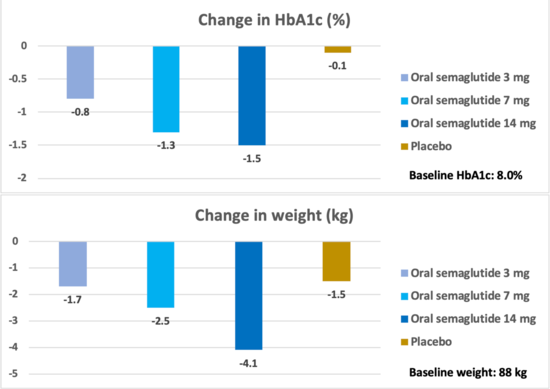
PIONEER 2: Daily oral semaglutide versus empagliflozin 25 mg in people with type 2 diabetes
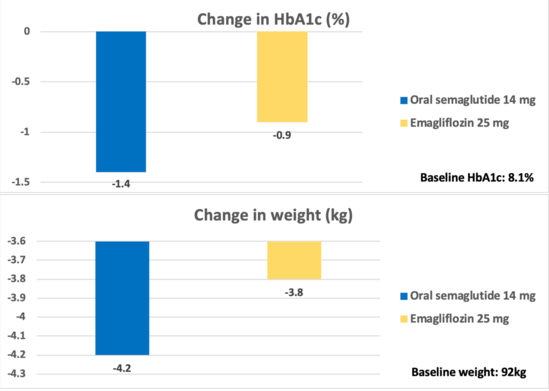
PIONEER 3: Daily oral semaglutide versus sitagliptin 100 mg in people with type 2 diabetes

PIONEER 4: Daily oral semaglutide versus liraglutide 1.8 mg in people with type 2 diabetes
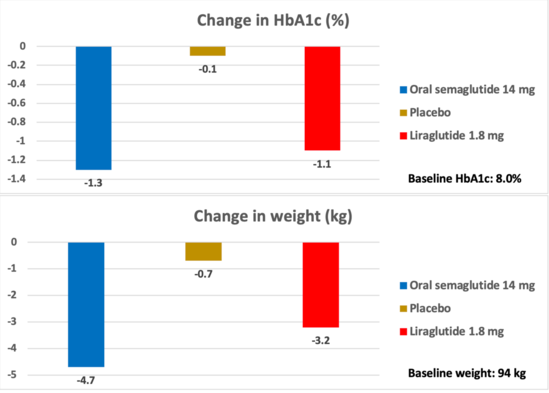
PIONEER 5: Daily oral semaglutide versus placebo in people with type 2 diabetes and moderate renal impairment
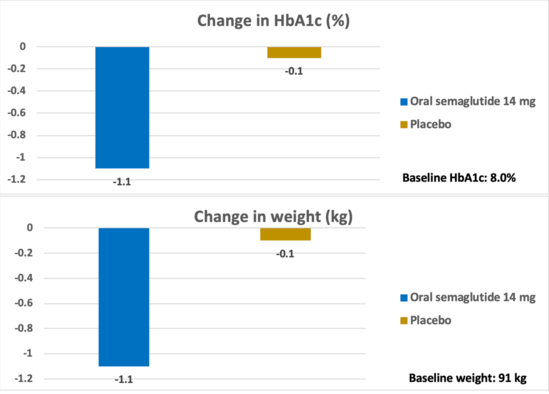
PIONEER 6
PIONEER 7: Daily oral semaglutide using a flexible dose adjustment based on clinical evaluation versus sitagliptin 100 mg in people with type 2 diabetes
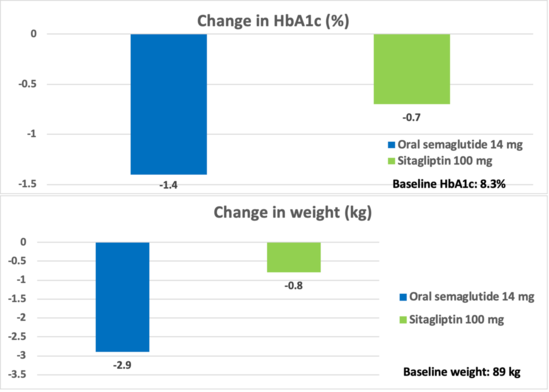
PIONEER 8: Effects of daily oral semaglutide versus placebo in people with long duration of type II diabetes treated with insulin
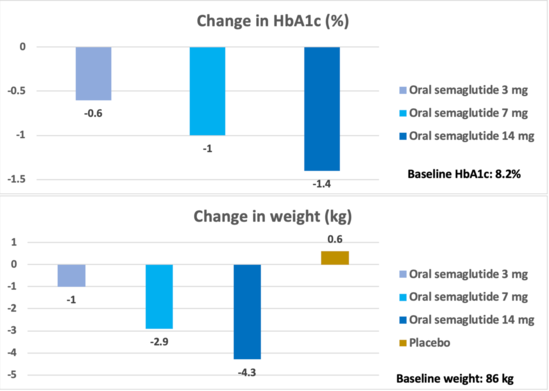
OF NOTE: PIONEER 9 and PIONEER 10 were Japanese studies and PIONEER 6 was a cardiovascular safety study.
Safety
Contraindications:
Similar to other GLP-1 RAs, semaglutide is contraindicated in patients with personal or family history of medullary thyroid carcinoma and/or patients with multiple endocrine neoplasia syndrome type 2. In addition, semaglutide is contraindicated in patients with hypersensitivity to semaglutide or any component of the formulation.
Adverse Reactions:
The most common adverse reactions associated with semaglutide include: GI adverse effects (32%-41%), increased serum lipase (30%-34%), nausea (11%-20%), increased amylase (10%-13%), abdominal pain (6%-11%), and diarrhea (9%-10%).
Special Populations
Pediatrics:
The safety and efficacy of semaglutide has not been established in patients younger than 18 years of age.
Geriatrics:
No differences in efficacy and safety were noted in geriatric patients treated with semaglutide. However, greater sensitivity in certain elderly individuals cannot be ruled out.
Pregnancy:
There is insufficient data evaluating the drug-associated risk of semaglutide use in pregnant women. Based on animal studies, there may be potential risk to fetus via semaglutide exposure during pregnancy. The manufacturer recommendations are to discontinue semaglutide at least 2 months prior to planned pregnancy. Semaglutide should only be used in pregnant women if the potential benefit outweighs potential risk to the fetus.
Lactation:
There are no data available regarding the presence of semaglutide in human milk or its effect on milk production and impact on breastfed infants. In animal studies, semaglutide was present in milk of lactating rats. Due to unknown risks, semaglutide is not recommended in breastfeeding mothers.
References:
- Rybelsus® [package insert]. Plainsboro, NJ: Novo Nordisk Inc; January 2020.
- American Diabetes Association. Pharmacologic Approaches to Glycemic Treatment: Standard of Medical Care in Diabetes-2020. Diabetes Care. 2020 Jan; 43(Suppl 1): S98-S110.
- Novo Nordisk - a focused healthcare company. https://www.novonordisk.com/content/dam/Denmark/HQ/investors/irmaterial/investor_presentations/2019/20190809_Q2%202019%20roadshow%20presentation%20vFinal.pdf. Accessed January 27, 2020.
- Aroda VR. A review of GLP-1 receptor agonists: Evolution and advancement, through the lens of randomised controlled trials. Diabetes Obes Metab. 2018 Feb;20 Suppl 1:22-33.





